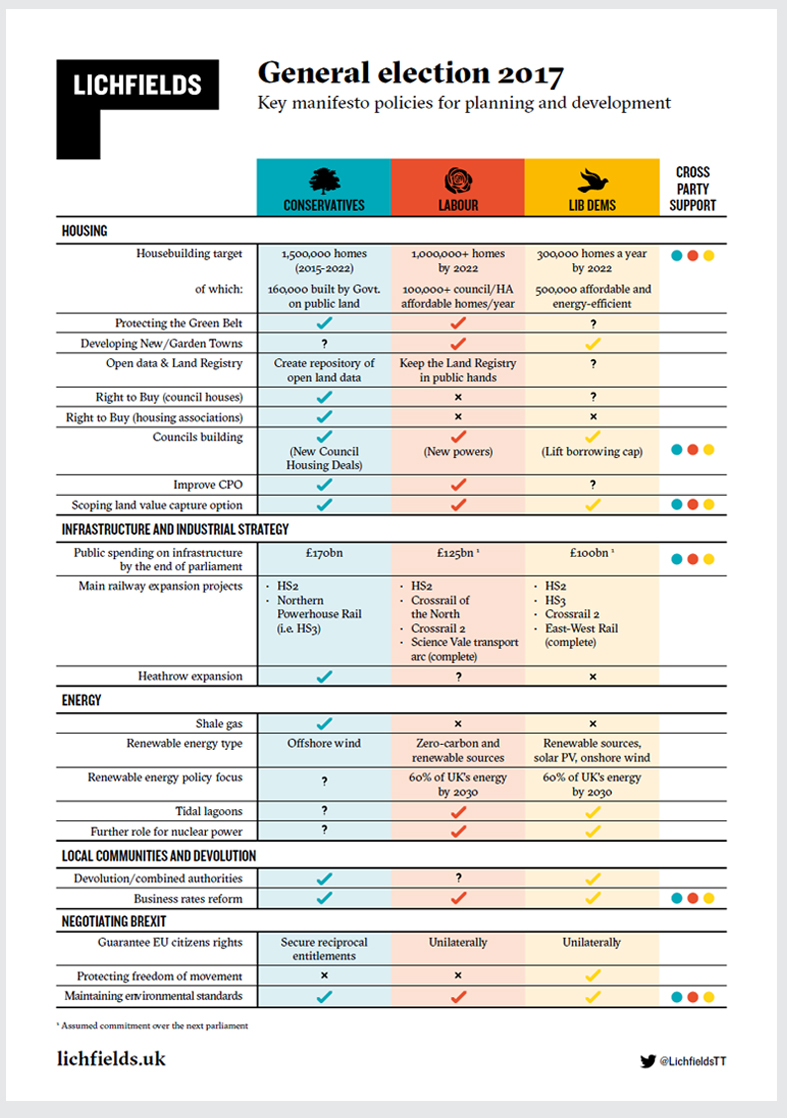19 July 2017 update: the first Regulations commencing a series of provisions in the Neighbourhood Planning Act 2017 were laid on 18 July and are already in force.
Of the Act’s development management changes, the Neighbourhood Planning Act 2017 (Commencement No. 1) Regulations 2017 mean that the Secretary of State (SoS) can now go ahead and make another set of regulations that will be about what kind of conditions may or may not be imposed on a grant of planning permission (s14 of the Act). Regulations can be made now too, governing the circumstances when the agreement of an applicant has to be obtained in advance and when it does not, to the terms of a pre-commencement condition.
Also, s1 is now in force so that a local planning authority has to have regard to a ‘post-examination’, unmade neighbourhood development plan (‘neighbourhood plan’) as a material consideration in the determination of planning applications. With s3 now in force too, it is the case that just prior to a draft neighbourhood plan being made after succeeding at referendum, the Plan forms part of the development plan (but it would not continue to do so if the LPA were to decide it should not be made).
S16 of the Act has now amended the New Towns Act 1981, so that the SoS can transfer the overseeing of new town development corporations established under that Act to one or more local authorities covering the New Town area. The SoS can also now make further Regulations for how a local authority should then go about overseeing the New Town’s development.
This guide provides a summary of the measures in the Neighbourhood Planning Act 2017 that relate to development management procedures in England, other than those for planning conditions – covered in Lichfields’ ‘essential guide to future changes - the use of conditions’.
Also affecting development management are the Act’s provisions that will alter: the status and materiality of draft neighbourhood plans at given stages; requirements for notification for neighbourhood planning bodies; and local authority planning registers.
The new legal requirement to further amend the Town and Country Planning (General Permitted Development)(England) Order 2015 (as amended), to alter permitted development rights (PDRs) for pubs and other drinking establishments, has already been fulfilled by amendments in force from 23 May.
Lichfields’ ‘
essential guide to changes to plan-making’ covers the changes relating to local plans and neighbourhood plans that will arise from the Act.
Changes to the materiality and status of advanced draft neighbourhood plans
Once
section 3 is brought into force, a draft neighbourhood development plan (‘neighbourhood plan’) will become part of the development plan just
before being made, once it has succeeded at referendum (but it would not continue to do so, if the local planning authorities (LPA) decides it should not be made).
And prior to that, a ‘post-examination’, unmade neighbourhood plan will have to be taken into account in the determination of planning applications when
section 1 is brought into force. The Act defines a post-examination neighbourhood plan and stipulates when a draft neighbourhood plan would cease to be considered to be a post-examination neighbourhood plan.
These sections should be read in the context of past appeal decisions not always being in line with advanced draft neighbourhood plans (see the Housing and Planning Minister’s jovial reference to a
‘Malthouse clause’), and a perception that some authorities are not doing enough to support neighbourhood planning (
hence the other neighbourhood planning provisions in the Act).
The inclusion of an unmade plan in the statutory development plan is a significant conceptual and legal change, but not an enormous leap in practice, as it is likely that very significant weight would be attached to such an advanced draft neighbourhood plan as a material consideration in any event.
Indeed, at the fourth sitting of the Commons Committee stage the Housing and Planning Minister quoted
para 216 of the NPPF, regarding the weight to be given to emerging plans, in order to “help” the Committee to understand the provision.
And regarding the weight to give a draft plan,
Baroness Parminter noted at Committee Stage in the Lords:
“Clause 1 says that local authorities “must have regard” to neighbourhood development plans, but there are no sanctions. Furthermore, this applies only to post-examined plans, whereas case law says that draft plans should be taken into account.”
The Housing and Planning Minister had
previously explained that (the then) Clause 1 was about giving communities the confidence, through legislation rather than guidance, that their neighbourhood plans “will get proper consideration in planning decisions, where the plan is material to the application” because the hours communities put in to preparing them should be “recognised in the system at the earliest possible opportunity”.
Therefore the provision in section 3 in particular is more about motivating communities and ‘sending a message’, than about making a significant change to the weight to be given to neighbourhood plans.
As Mr Barwell
said towards the end of the Bill’s passage:
“We want to ensure that this process helps people who give up their spare time and put effort into producing neighbourhood plans to get the result they want in terms of how their local community develops.”
Notification arrangements for sites where there is a neighbourhood plan, or a post-examination draft neighbourhood plan
Once all of
section 2 is in force, LPAs must notify parish councils and neighbourhood forums of applications for planning permission, permission in principle (PIP) or reserved matters approval (and any alterations to those applications), on land where there is a draft neighbourhood plan, or a post-examination draft neighbourhood plan, unless the parish council has advised the LPA that it wishes to be notified of certain applications, or does not wish to be notified at all. The requirement does not extend to technical details consent applications that follow PIP, which is an interesting omission given the
Government’s intention that mandatory engagement at the technical details stage will be “proportionate” and its desire to promote engagement with neighbourhood planning to LPAs.
This provision, which amends/will amend Schedule 1 of the Town and Country Planning Act 1990, will operate alongside the pre-existing requirement in Schedule 1 to notify parish councils and neighbourhood forums of planning applications and reserved matters approval applications (and any alterations to those applications) where they have requested to be notified.
The amendment to Schedule 1 in force thus far, only has the effect of allowing changes to the automatic notification procedure to be set out in the amendments to the Town and Country Planning (Development Management Procedure) (England) Order 2015 (Articles 25 and 25A). We are seeking clarification as to which sub-sections of section 2 have been brought into force, and understand that it is section 2(1-5).
Planning register
Section 17 permits regulations requiring LPAs to include prior approval applications, decisions and notifications on their planning registers –whether the authority has responded or not to an application. Regulations may also stipulate the information to be included in the register, and the circumstances when an application or notification may be removed from it. The inclusion of this information on the planning register is intended to lead to the accurate recording of the number of homes permitted via PDRs.
The section requiring LPAs to include prior approval applications and prior notifications on the planning register has commenced (new section 69A of the Town and Country Planning Act 1990), but a development order prescribing the information to be recorded is outstanding.
A draft Town and Country Planning (Development Management Procedure) (England) (Amendment) Order - 2017?
December 2016’s ‘
The Neighbourhood Planning Bill: Further information on how the Government intends to exercise the Bill’s delegated powers’(the ‘further information document’) includes a draft amendment to the Town and Country Planning (Development Management Procedure) (England) Order 2015, which relates solely to housing prior approval applications that will create additional dwellings. If it were brought into force as drafted, LPAs would have to keep all information submitted with, or in respect of a housing prior approval applications in its planning register, including any statement specifying the net increase in dwellinghouses proposed by the development, and any legal agreements.
Given that the amendment to the Order has been drafted, and the May Government’s (and probably the new Government's) desire to monitor the number of new homes being built or converted, one can expect this provision to be fully in force by the end of the year.
Changes to permitted development rights for drinking establishments
During the passage of the Act, there was much debate regarding PDRs and pubs, and some MPs and Lords expressed strong concerns regarding pub closures. The outcome of these debates is that the Town and Country Planning (General Permitted Development) (England) Order 2015 (GPDO) was legally required to be amended as set out by
section 15.
The main change is that the previously available PDRs for the change of use or demolition of drinking establishment have been removed. The Lords had sought to delete Use Class A4*, drinking establishments, but
the Government thought that this would risk unintended consequences, and would limit opportunities for pubs to expand without seeking planning permission.
The Town and Country Planning (General Permitted Development) (England) (No. 2) (Amendment) Order 2017
As
required by the Neighbourhood Planning Act 2017, and within the timescale
promised in the Lords,
amendments to the Town and Country Planning (General Permitted Development) (England) Order 2015 removing certain PDRs for pubs will come into force on 23 May 2017. The Lichfields’ ‘
Guide to the Use Classes Order’ has been updated to reflect this change.
The Town and Country Planning (General Permitted Development) (England) (No. 2) (Amendment) Order 2017 (‘GDPO amendment’) removes PDRs to change drinking establishments (use class A4) to use class A1 (shops), A2 (financial and professional services), or A3 (restaurants). Temporary rights to change from a drinking establishment, or ‘a drinking establishment with expanded food provision’ to a school, and to use classes A1, A2 or A3, will also be removed at the same time (
Article 3 of the Amendment Order). ‘Drinking establishments with expanded food provision’, where a pub or other drinking establishment use operates concurrently with a use falling within Class A3, is a new typology that has been introduced by the GPDO amendment. ‘Drinking establishments with expanded food provision’ are not defined further.
New
Class AA PDRs added to Part 3, Schedule 2 will permit change of use from drinking establishments to drinking establishments with expanded food provision, with no limitations or conditions. Drinking establishments with expanded food provision may not change to a restaurant without applying for planning permission.
Planning permission will also be required to
demolish a drinking establishment, or a drinking establishment with expanded food provision.
As a consequence of the removal of these rights, the current requirement to establish with the LPA whether the drinking establishment has been nominated as an asset of community value will be removed, as it is no longer relevant.
There are transitional arrangements: where a request for confirmation from the LPA as to whether the building has been nominated or listed as an asset of community value was made more than 56 days before 23 May, the development can begin. For demolition, prior approval must have been granted, determined to not be required or deemed granted before 23 May.
New permitted development right Class AA is postponed for 18 months, for buildings which fall within the scope of an Article 4 direction that withdraws permission to change use from Class A4 to Class A3. This will give LPAs sufficient time to draft and then advertise any amendments to an Article 4 Direction, or prepare any new Article 4 Directions that are considered necessary.
Compensation rules relating to Article 4 directions are being amended to reflect the new Class AA right.
Local accountability for New Town Development Corporations
Section 16 will allow the transfer of functions under the New Town Act 1981 from central government to one or more local authorities within the area proposed for a New Town. Regulations can then be made for how the local authority should oversee the New Town's development.
It was added to the Bill at
Third Reading in the Lords, in an amendment tabled by Lord Taylor, Lord Best and Lord Lucas, and followed an
earlier debate during the passage of the Bill, which led to subsequent discussions between Lord Taylor and DCLG officials, and to referencing the (then future) amendment (being referred to) in the Housing White Paper (
para 1.36). Consequently the amendment was accepted by the Government.
At Third Reading Lord Taylor argued:
“In the modern world, it is not right that in seeking to deliver a new settlement through a new town corporation to ensure that it is delivered at quality and pace to meet local needs a local council would surrender all the powers to the Secretary of State... This is a localising measure. It hands really strong power to communities to ensure that new towns are delivered at quality.”
The draft regulations will need to be approved by resolution of each House of Parliament.
New government - new DCLG ministers and a new approach?
In my view, a new Conservative government would be unlikely to change tack on the development management changes outlined here (despite the pub PDR changes being rushed through). Furthermore, Gavin Barwell has dropped a number of heavy hints about his desire to return to the Department of Communities and Local Government, and should this happen, an altered approach is even less likely.
Expect full steam ahead from 19 June.
Sources
Improving the use of planning conditions, public consultation
Government response to the consultation on improving the use of planning conditions
The Neighbourhood Planning Bill: Further information on how the Government intends to exercise the Bill’s delegated powers
The Neighbourhood Planning Bill 2016/2017 Delegated Powers Memoranda
*Use Class A4 ‘drinking establishments’ includes public houses, pubs, and bars







